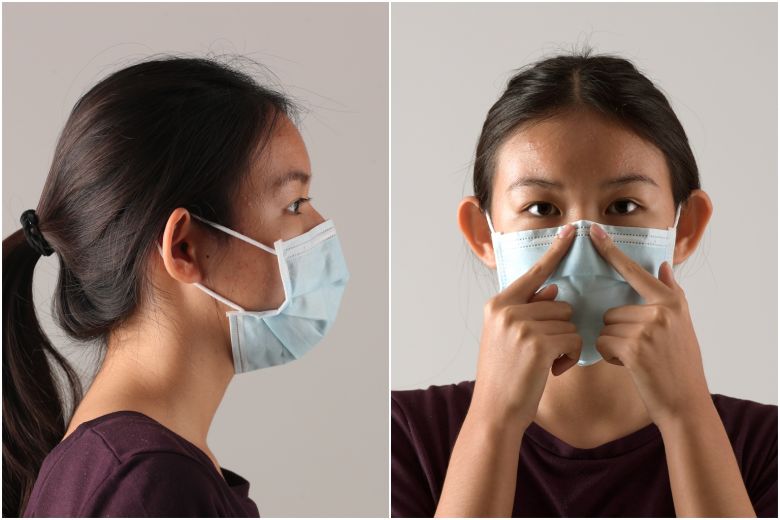At this point in the pandemic, the Centers for Disease Control and Prevention’s (CDC) basic guidelines are pretty clear: everyone should be social distancing at least six feet in public, washing their hands regularly, and wearing a face mask whenever leaving the house. And while there really aren’t any complexities to the first two rules, your choice of face mask could be putting others in danger without you even realizing it.
New research shows that if your face mask has a ventilation valve on it, it can easily spread COVID. In fact, experts warn you should stop using these kinds of masks immediately. Read on to find out why you should toss this type of PPE, and for more on where a good face mask might be more important than ever, check out These States Are Starting to Lock Down Again.
Research engineers at the National Institute of Standards and Technology (NIST) recently developed a visualization of the ways that infected patients spread the novel coronavirus when exhaling. With special imaging technology and a mannequin head exhaling droplets, scientists were able to see that while regular N95 masks completely stop the passage of droplets, N95 masks outfitted with a ventilator valve do almost nothing to stop the spread. In tests with masks with valves, the droplets moved almost as far and as quickly as they did in the tests where the mannequin was without any kind of face covering at all.
“When you compare the videos side by side, the difference is striking,” Matthew Staymates, the NIST research engineer who created the visualization, said in a statement. “These videos show how the valves allow air to leave the mask without filtering it, which defeats the purpose of the mask.”
In conclusion, Staymates reiterated one of the CDC’s most often repeated reminders: “I don’t wear a mask to protect myself. I wear it to protect my neighbor, because I might be asymptomatic and spread the virus without even knowing it,” he said. “But if I’m wearing a mask with a valve on it, I’m not helping.”
Besides avoiding these types of PPE, there’s more you can do to get the most out of your mask. Read on to find out how, and for more on the signs of a potential coronavirus infection, know that If Everything You Drink Smells Like This, You May Have COVID, Experts Say.
1. You should be washing it more often

The whole idea of wearing a face mask is to keep yourself and others safe from the coronavirus. But according to a meta-analysis published in BMJ Open in October, wearing a face covering that hasn’t been washed at the end of the day can negate all of your efforts by putting you at risk of exposure to the virus.
“Both cloth masks and surgical masks should be considered ‘contaminated’ after use,” Raina MacIntyre, PhD, who conducted the study, said in a statement. “Unlike surgical masks, which are disposed of after use, cloth masks are re-used.
While it can be tempting to use the same mask for multiple days in a row, or to give it a quick hand-wash or wipe-over, our research suggests that this increases the risk of contamination.” And for more on what’s expected with the pandemic in the coming weeks, Here’s Who Will Cause a COVID Surge This Month, Experts Say.
2…But don’t wash them with harsh chemicals.

Clean is a good thing when it comes to face masks, but too clean could be putting you in a dangerous position, too. According to a report from The New York Times, you should never use bleach when washing your cloth masks—no matter how tempting it may be to disinfect them with something so notoriously powerful.
That’s because harsh chemicals like bleach and hydrogen peroxide can degrade the fabric fibers over time, making them less effective at containing viral particles. And for more on risky behavior amid the pandemic, check out Going Here Every Day Doubles Your Chances of Catching COVID, CDC Says.
3. It should have three protective layers.

The skyrocketing demand for face masks has led to thousands of companies entering the market and peddling their products online. Unfortunately, similarly to masks with ventilation valves, masks that are made without enough layers won’t do enough to protect others from particles you exhale, according to a set of guidelines released by the Association of American Medical Colleges (AAMC). And for more up-to-date information on COVID, sign up for our daily newsletter.
4. Bandanas work in a pinch, but they aren’t ideal.

The AAMC guidelines also state that bandanas and other loosely folded cloth coverings provide the least amount of protection, but are better than no face mask at all. In fact, a June study from Florida Atlantic University (FAU) that compared different materials used to make DIY or homemade face coverings found that mannequins covered by a bandana simulating a coughing patient still sent particles flying more than three feet.
“Loosely folded face masks and bandana-style coverings provide minimal stopping-capability for the smallest aerosolized respiratory droplets,” the FAU scientists concluded. And for more signs to be aware of as the virus spreads, know that This Strange Symptom May Be the Earliest Sign You Have COVID, Study Says


